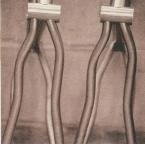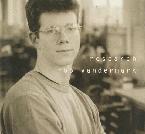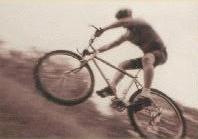

S-Bends, V-Bends, Newsboy bends--welcome to Rob Vandermark's world, where the best way from here to there is sometimes on the edge of an arc.


What does the decal "Designed by Rob Vandermark" mean?
I guess it's all the geometry choices and tubing choices for all the sizes, the welded parts and what their shapes will be, what the bike is going to be used for and how it will ride--pretty much everything except the road bike geometry and ride quality, which are done by Tom Kellogg because he has more experience there.
Another part of it is incorporating titanium into a bike. The design for titanium shouldn't be the same as steel, say, if you want to take advantage of the titanium.
How is titanium different?
Its modulus is lower than steel, but its fatigue endurance is higher. So it is more flexible, but it also tolerates being flexed better. If you used the same size titanium chainstay as a steel chainstay, for instance, the ti stay would be twice as flexible and that would be a nasty bike to ride. But since titanium's fatigue endurance is roughly double that of steel, you can let it flex more in the seatstays for a better ride, and then beef up the bottom bracket and chainstays to keep them rigid.
So how do you design your frames?
Overall, the main thing is having them torsionally stiff but vertically compliant. Keep the powertrain efficient without losing that "titanium" ride. A lot of the balance that you strike there is in the tubing geometry--using different thicknesses and diameters--and some of it is in the frame geometry.
Merlin uses almost 50 different tube sizes in its frames. Why so many?
Mostly to keep the performance consistent for all the different frames. You design one size--for road frames, I start with a 58, for mountain, a 17.5, because that's what fits me--and then you try to make all the other sizes ride the same way.
With a road bike you want resiliency, so I try to keep the ride compliance equal in all sizes. With a mountain bike, I try to get the weight out without affecting the torsional stiffness.
For example, on a mountain bike, you could use the tubeset from a 21.5 throughout the whole range and they would all ride fine, assuming they were always used with suspension forks, but the 13.5 would be pretty heavy for its size. Whereas with a road bike, if you used one tubeset for the whole range, one of them would ride all right but the rest wouldn't be as good, which has to do more with resiliency than with weight.
Does Merlin's MTS325 tubing have a different ride than standard 3-2.5 tubing?
No; the ride differences come from those 47 custom sizes. The MTS325 specs define the tighter tolerances for purity, straightness and surface finish. The straightness spec is self-explanatory--it helps us build straighter frames, with minimal cold-setting. The finish spec is more complicated, but basically it gives our tubing much better fatigue endurance.
Let's go back to design. Do you design the bikes as racing bikes first?
Yes, Tom and I definitely lean toward racing, in part because a good racing bike, as long as it is durable, can be used for anything, even touring. That's not to say that some racing designs might not be too extreme for other use, but we pull back from that. Our steering is predictable, for example. You don't want to be super tense and on top of the bike all the time when you race. And that geometry works for other things.
How do you determine sizing?
For mountain bikes, the top tube is figured first, and then I work on seat tube length. I prefer to have the seat tube as short as possible in order to get as much standover clearance as possible, but if you go too short, then you can't get your arm through the frame to shoulder the bike, which again is a racing thing that I think is important.
For the road bikes, Tom uses formulas he's developed over the last 20-odd years. They're based on traditional European racing geometry, but adapted for the gains in size and weight we've seen in recent generations.
Are titanium bikes harder to build?
Definitely. A lot of it simply because of the time it takes to weld, and the care you have to take. Machining, finishing, all of that is harder. And the engineering; for most of what we do, there's no one book with all the answers.
You're always looking at new materials. Are you going to be building something else in five years?
I don't think so. Even among titanium alloys, none can do everything 3-2.5 can do. That could change if we succeed in making seamless 6-4. Right now, all the 6-4 tubing that is around is seamed tubing, and that's no good for bike frames. But we are optimistic that the problems can be solved. Still, 3-2.5 and 6-4, as tubing, aren't that much different, so even if we do make seamless 6-4, we will have to scrutinize the benefits before we commit to the cost. Other materials, such as the various fibers or metal matrix composites, have good properties for some bike applications, but not for frames.
Last question: Is that really your signature on the chainstay?
It is, one of about 100 attempts. Actually the Rob is from one try, and the Vandermark is another. My real signature is illegible.
[
Back |
Next
]
[
Notions |
Specifications |
Features |
Dealers |
Communication |
Album
]





